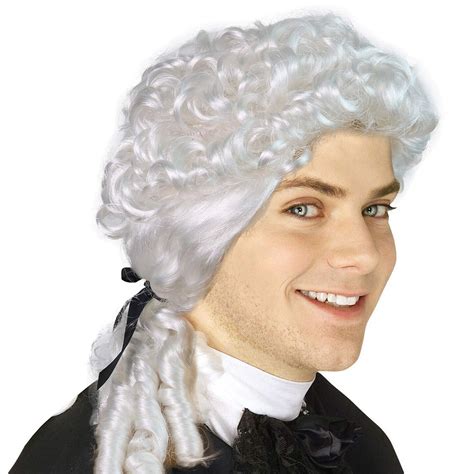A Historical Icon with Enduring Legacy
Since its inception in the 17th century, the classical powdered wig has left an indelible mark on fashion and social history. Its intricately styled curls and gleaming white finish have adorned the heads of countless notables, from European royalty to American revolutionaries.

Today, this iconic accessory continues to captivate designers, historians, and anyone drawn to its timeless allure.
The Evolution of the Powdered Wig
The powdered wig emerged during the reign of King Louis XIV of France (1643-1715). It quickly became a symbol of status and sophistication among the upper classes in Europe. By the 18th century, the wig had reached its peak of popularity, with elaborate styles featuring intricate flourishes and multiple tiers of curls.
As the 18th century progressed, the powdered wig began to lose its association with the aristocracy. It became more commonplace among the middle classes and even some members of the working class. By the end of the century, the wig had fallen out of fashion entirely, replaced by shorter and more natural hairstyles.
Modern Interpretations of the Powdered Wig
Despite its decline in popularity, the powdered wig has never truly disappeared. It has been revived periodically throughout history, most notably during the Romantic era of the 19th century and the Rococo revival of the 20th century.
In recent years, the powdered wig has experienced a renewed resurgence, thanks in part to its prominent use in period dramas and historical films. Designers have also begun to incorporate elements of the powdered wig into contemporary fashion, creating modern takes on this timeless style.
Applications of the Powdered Wig
While the classical powdered wig is primarily associated with historical reenactments and costuming, it has also found applications in other areas:
- Fashion: Designers are increasingly using powdered wigs as a way to add a touch of whimsy and elegance to their collections.
- Theater and Opera: Powdered wigs are a staple in period productions, helping to create an authentic and immersive experience for audiences.
- Costuming: Historical reenactors and cosplayers rely on powdered wigs to complete their outfits and bring their characters to life.
Benefits of the Powdered Wig
- Historical Authenticity: Powdered wigs provide a sense of authenticity to historical reenactments, costumes, and productions.
- Style and Elegance: The powdered wig is a timeless fashion accessory that can add a touch of sophistication and elegance to any outfit.
- Imagination and Creativity: Powdered wigs can inspire creativity and imagination, allowing individuals to explore different periods and characters.
Customer Engagement
- What historical figure or era most inspires you, and why?
- How would you like to incorporate the powdered wig into your own wardrobe or lifestyle?
- What unconventional uses for the powdered wig can you imagine?
Table 1: Historical Significance of the Powdered Wig
| Era | Significance |
|---|---|
| 17th Century | Emergence as a symbol of status in France |
| 18th Century | Height of popularity, with elaborate styles |
| 19th Century | Revival during the Romantic era |
| 20th Century | Rococo revival and use in historical productions |
| Present Day | Resurgence in fashion and costume design |
Table 2: Applications of the Powdered Wig
| Application | Purpose |
|---|---|
| Historical Reenactment | Authenticity and immersion |
| Costuming | Characterization and realism |
| Fashion | Whimsy and elegance |
| Theater and Opera | Period accuracy and atmosphere |
Table 3: Benefits of the Powdered Wig
| Benefit | Value |
|---|---|
| Historical Authenticity | Immersion and educational value |
| Style and Elegance | Timeless accessorizing |
| Imagination and Creativity | Exploration of different eras and characters |
Table 4: Customer Questions on the Powdered Wig
| Question | Purpose |
|---|---|
| What historical figure inspires you? | Understanding customer interests |
| How would you use the powdered wig? | Exploring customer creativity |
| What unconventional uses can you imagine? | Stimulating innovative thinking |
